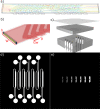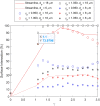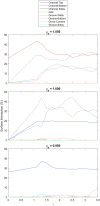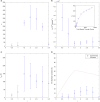Herringbone micromixers for particle filtration
- PMID: 36704613
- PMCID: PMC9873379
- DOI: 10.1063/5.0134431
Herringbone micromixers for particle filtration
Abstract
Herringbone micromixers are a powerful tool for introducing advection into microfluidic systems. While these mixers are typically used for mixing fluids faster than the rate of diffusion, there has been recent interest in using the device to enhance interactions between suspended particles and channel walls. We show how the common approximations applied to herringbone micromixer theory can have a significant impact on results. We show that the inclusion of gravity can greatly alter the interaction probability between suspended particles and channel walls. We also investigate the proposed impedance matching condition and the inclusion of imperfect binding using numerical methods, and investigate transient behaviors using an experimental system. These results indicate that while traditional methods, such as simple streamline analysis, remain powerful tools, it should not be considered predictive in the general case.
© 2023 Author(s).
Figures





Similar articles
-
3D nanomolding and fluid mixing in micromixers with micro-patterned microchannel walls.Nano Converg. 2017;4(1):4. doi: 10.1186/s40580-017-0098-x. Epub 2017 Mar 1. Nano Converg. 2017. PMID: 28303213 Free PMC article.
-
Engineering and analysis of surface interactions in a microfluidic herringbone micromixer.Lab Chip. 2012 Aug 7;12(15):2634-7. doi: 10.1039/c2lc40356k. Epub 2012 Jun 15. Lab Chip. 2012. PMID: 22706612
-
Micromixers and their applications in kinetic analysis of biochemical reactions.Talanta. 2019 Dec 1;205:120136. doi: 10.1016/j.talanta.2019.120136. Epub 2019 Jul 9. Talanta. 2019. PMID: 31450434 Review.
-
Design and simulation of the micromixer with chaotic advection in twisted microchannels.Lab Chip. 2003 May;3(2):77-81. doi: 10.1039/b211091a. Epub 2003 Apr 17. Lab Chip. 2003. PMID: 15100786
-
A Review of Pressure Drop and Mixing Characteristics in Passive Mixers Involving Miscible Liquids.Micromachines (Basel). 2024 May 24;15(6):691. doi: 10.3390/mi15060691. Micromachines (Basel). 2024. PMID: 38930661 Free PMC article. Review.
References
-
- Hassell D. and Zimmerman W., “Investigation of the convective motion through a staggered herringbone micromixer at low Reynolds number flow,” Chem. Eng. Sci. 61, 2977–2985 (2006). 10.1016/j.ces.2005.10.068 - DOI
-
- Cantu-Perez A., Barrass S., and Gavriilidis A., “Residence time distributions in microchannels: Comparison between channels with herringbone structures and a rectangular channel,” Chem. Eng. J. 160, 834–844 (2010). 10.1016/j.cej.2009.07.023 - DOI
Grants and funding
LinkOut - more resources
Full Text Sources
